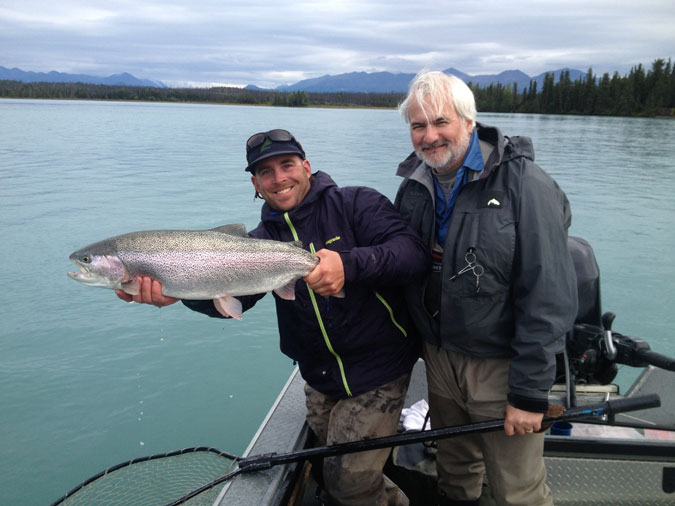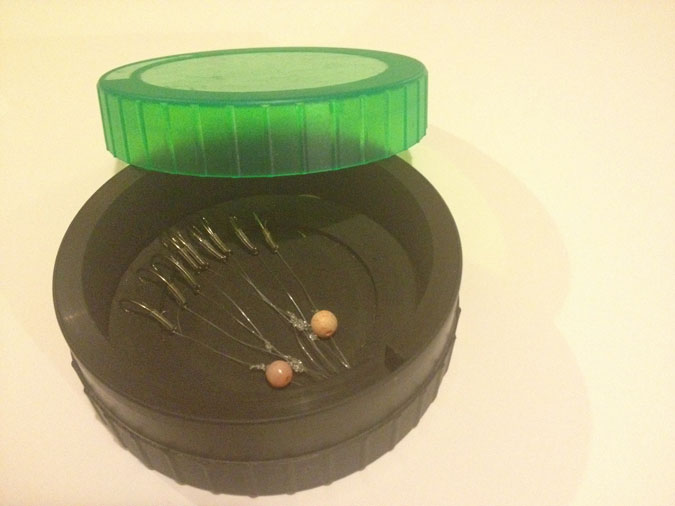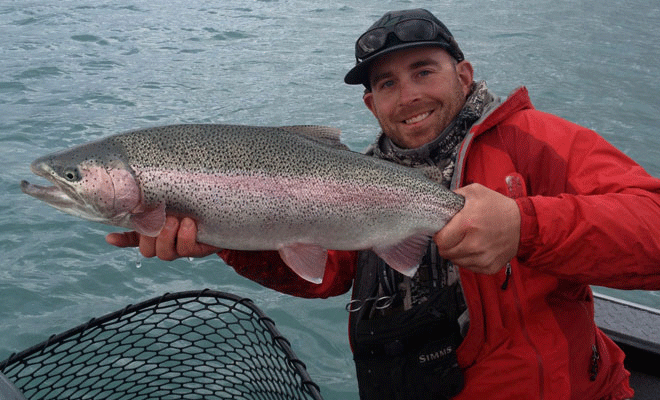Story & Photos by Nick Ohlrich
“I think your drift is a touch fast. Try having your rod tip follow the indicator,” I said to my clients, who were making first casts in the glacial-green Kenai.
“Perfect. Now maximize the entire drift; cast to the two o’clock position off the bow of the boat. Let it drift to the hang-down.” All this was kind of hard to say, but not because I have never seen someone run a drift too fast or not use the entire drift, but because my face was still frozen. A 20-minute run up the Kenai River from Bings Landing on a crisp September morning can make talking tough. The morning bite was about to start, and no one was around (at least for now). This was the time to get dialed in on running a perfect drift.
“It’s a numbers game,” I continued. “The longer your gear is on the bottom of the river, floating the same speed as the current, the more opportunity you have for getting a bite.” As with most of our guests, a little bit of coaching soon has this angler running a great drift.
I talk less once a good drift becomes every drift, and we enjoy the peace of the early morning river. The silence is interrupted as our goal is met by feeling the power and cunning of a supercharged Kenai River rainbow trout.
Being a Kenai River guide and co-owner of Alaska Drift Away Fishing for the past decade I have definitely seen the good, bad and ugly of drift presentations. There are several factors that go into play when trying to deliver a convincing drift to your quarry.
The Setup
Leader length and construction is a great place to start. Here are a few questions you can ask yourself when preparing your setup: How deep is the water that I will be fishing? What is the current speed? What is the water clarity?
The middle Kenai River below Skilak Lake has an average depth of 8 feet and it is where we conduct most of our business for rainbows. I like to run leader lengths from 10- to 13 feet, depending on current speed and depth of the area that I am fishing. This longer leader allows for a nice belly and also some insurance that your gear is on the bottom in the strike zone.
Our leader setup is extremely simple. The butt section is 12 inches of 30-pound copolymer. A loop tied at both ends makes this a quick and easy connection to the fly line and leader. Next, attach 4- to 6 feet of 14-pound fluorocarbon to the butt end with a loop. Using a double surgeon’s knot, attach 3- to 4 feet of 12-pound fluorocarbon to the 14-pound. Tie the tag end of the 12-pound into a loop. The loop is a great place to attach split-shot; this way you will not run into the problem of it sliding around on your leader. The tippet length is 18 inches typically. I run 12-pound flouro, but if the water is clear I’m not afraid to tie up 10-pound or even 8-pound flouro. Connecting your tippet to the leader using a loop-to-loop allows for an easy pattern change/tippet change, without having to cut into your leader or tippet.
We also tie our hooks on with a snell or egg-loop knot. Besides always having a straight hook-set, egg-looping 12-pound flouro to a size 8 hook is great for finger dexterity. One other note about tippets is it is best to pre-tie. This is the part of the leader system that gets the most abuse and will need to be changed more than any other section. Purchasing a Pip’s box and filling it with 10 pre-tied tippets will have you thanking yourself when out on the water.

Clients appreciate Nick’s willingness to share tricks to rainbow success.
Getting your Shot Together
Now that you have successfully tied an amazing leader and pre-tied 1million tippets, you need to get your shot together. B, BB and 3/0 split-shot are the three sizes that I carry. Two 3/0 split-shots seem to be the magic number for bead and flesh patterns. In deep, fast water, three or four 3/0 may be needed, or on the reverse side, slow, shallow water may require one 3/0 or B/BB combos. Play around with weight configurations. Adding and subtracting weight may be needed to achieve your desired drift speed. If you notice that you are constantly getting hung up, try reducing the weight. If you’re still getting hung up, check your leader length, as it may be too long for the water you are fishing.
It’s All About the Bobber
Most fly anglers that run a dead-drift on the Kenai use some form of an indicator (bobber). You are going to see a bite on the indicator before you feel it 98% of the time. Kenai trout are getting smarter by the minute and will probably spit your pattern before you can feel it and then get a good hook-set. The indicator also allows you to fish away from the boat or shore and still maintain a great drift.
There are several things people use for indicators: Corkies, Spin ’n Glos, yarn, balloons and the newest indicator, the Thing A Ma Bobber. The Thing A Ma Bobber is one of the greatest creations since sliced bread. This modern marvel helps deliver a smooth drift that doesn’t get sucked down by turbulent topwater and it is also super light, so you don’t get as much interference when casting. This is the only indicator Alaska Drift Away Fishing and most serious trout guides on the Kenai use.
Boat Control = Drift Control
The Kenai River below Skilak Lake is quite a large body of water, which is most effectively fished with a power or drift boat. A boat and its captain are an intricate part of the drift presentation and angling success.
First, we run our powerboats with the bow upriver. This allows for the best boat and drift control. Now comes boat speed. Run your boat drift slightly slower than the fly drift, but not so slow that you sit in one place for too long. If you notice your anglers are constantly casting, lay off the gas. Running long drifts is the best way to find fish, properly target big fish and keep gear in the strike zone.
With that being said, once you have found fish there is definitely a right and a wrong way to work that zone. When working a dead-drift, start your drift way above your zone of intention. This allows for your anglers to set up and get their drift on. As you approach the target area, adjust the boat speed so your anglers are hitting the sweet spot in the middle of their drifts.
For those that like to swing streamers or run flesh flies, there are a few points to consider. When swinging streamers, most strikes occur when the fly begins to swing. Thoughtful planning of the boat speed, swing speed and target zone is extremely important. Ideally you want your anglers’ drifts to be in mid-swing as the fly enters the zone where fish are holding. As with the dead-drift, start your swing drift way above the fish.
Here are two reasons why I’m so adamant about starting your drifts high:
Anglers and the captain have ample time to get their drift and drift speed right, allowing for properly maximizing the sweet spot.
“Hot-lapping” an active hole where big fish are biting will cause the big fish bite to turn off fast. Not only are you killing the bite, but you are also advertising toeveryone else where you have found nice fish. A quick definition of hot-lapping: hitting the sweet spot and only the sweet spot, generally caused by excessive chomping and rookie decision-making.
If you are a drift boater the same philosophy can be applied. The stealth of the drift will allow you to stay in the sweet spot longer due to the lack of engine noise.
 Pre-tied leaders maximize fishing time.
Pre-tied leaders maximize fishing time.
Tying it Together
There you have it. Step one: gather the proper gear for rigging up your rod. I can’t stress how important it is to run fluorocarbon for your leader. It is definitely worth the extra cash. If you don’t believe me, rig up two rods identical, except one has a flouro leader and one has plain mono. See which one catches more.
Next is the exciting part: running the perfect drift. From shore, life is pretty easy. It is just you and your fishing spot. But once a boat comes in to play, practice, practice, practice! Running a good boat drift takes time. Fortunately the best way to master this skill is by going out and fishing.
Applying these techniques to your game will definitely increase your odds at hooking into that mega donkey trout. But running a perfect drift is only a third of the catching triad. Location and pattern are just as important as presentation. When all three principles are applied and the fish want to cooperate, magical things will happen.
Nick Ohlrich has been addicted to fishing throughout his whole life, making his decade-long career as a Kenai River rainbow trout and salmon guide a dream come true. His favorite part is seeing how excited people get when they tie into their first big Kenai ’bow.
This article originally appeared in the April 2014 issue of Fish Alaska.



